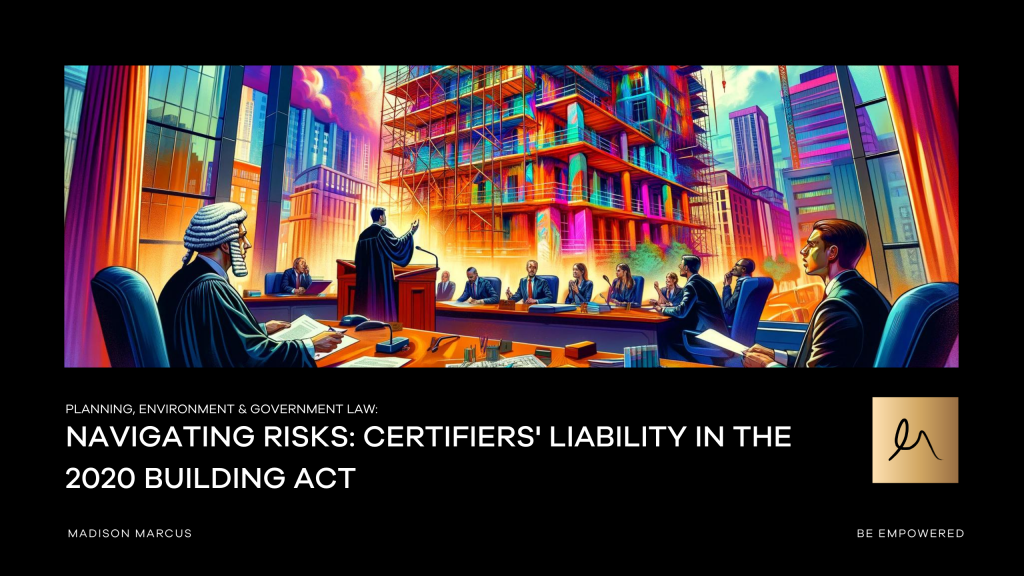The Design and Building Practitioners Act 2020 (“D&BP Act”) commenced on 10 June 2020. Case law is slowly informing the interpretation and application of the Act, particularly the duty of care provisions in Part 4. The latest judicial instalment is the NSW Supreme Court’s decision in University of Sydney v Multiplex Constructions Pty Ltd [2023] NSWSC 383. The decision in Multiplex Constructions Pty Ltd was not a final determination of the issues in dispute (the Court invited the University to “replead” its case), but, in the absence of a more persuasive decision, it does provide guidance for future matters involving the D&BP Act.
Part 4 of the D&BP Act, a comprehensive section, enshrines in statute a duty of care owed by any person who carries out construction work. The duty is owed to “each owner of the land in relation to which the construction work is carried out and to each subsequent owner of the land” (s37 D&BP Act). “Construction work” is defined broadly and includes “supervising, coordinating, project managing or otherwise having substantive control over” the carrying out of any building work.
The Supreme Court’s decision in Multiplex Constructions considered whether a registered certifier, who was responsible for certifying building work under the Environmental Planning and Assessment Act 1979, had “substantive control” over the building work, in which case the certifier came within the definition of a person carrying out construction work.
“The power was substantive because had the certificate been refused, the builder would have been obliged to change the design or materials of the building”.
The registered certifier issued a “Crown Completion Certificate” for cladding installed on a building known as the Charles Perkins Centre at the Sydney Campus of the University of Sydney.
The University alleged that the certifier carried out construction work within the defined meaning of that expression, because it had “substantive control” of the carrying out of the relevant building work by reason its statutory power to issue a completion certificate. The University submitted that the power was substantive because had the certificate been refused, the builder would have been obliged to change the design or materials of the building.
The Court referred to its earlier decision in Owners SP84674 v Pafburn Pty Ltd [2022] NSWSC 659, where the Court held that it is sufficient to enliven the expression “substantive control” to establish that a person is in a position where the person is able to control how the work is carried out. It is not necessary to establish that the person actually exercising the power to control the work.
“In this context, ‘substantive control’ refers to a person’s ability to control how the work is carried out, regardless of whether they actually exercise that power. If a certifier has this level of control, they are considered to be carrying out construction work under the D&BP Act”.
However, the Court held in Multiplex Constructions Pty Ltdthat neither the power to issue a compliance certificate nor the actual issue of that certificate amounted to the substantive control over the relevant work.
The decision in Multiplex Constructions Pty Ltdpotentially has broad application to other certification work, particularly inspections, under the EP&A Act. The decision did not consider the full range of powers available to a certifier undertaking certification work. It is conceivable that the power to issue a written direction notice requiring work to cease on a site, for example, is a type of power that a Court might consider amounts to substantive control over building work.
The Land and Environment Court reached a similar conclusion in Lismore City Council v Ihalainen (No2) [2014] NSWLEC 198, where it was held that a developer was not an occupier of a site for pollution purposes after the Council issued a stop work order. A certifier should carefully consider whether they have the power to issue a certificate before exercising that power.
The Design and Building Practitioners Act 2020 has introduced significant responsibilities for those involved in construction, particularly for registered certifiers. Understanding the extent of these duties and the legal interpretations that shape them is crucial for navigating potential liabilities. The evolving case law provides essential insights, underscoring the need for diligence and awareness in fulfilling statutory obligations.
Key Takeaways:
➡️ Duty of Care: The D&BP Act 2020 imposes a statutory duty of care on those performing construction work for current and future landowners.
➡️ Construction Work Definition: Broadly includes supervising, coordinating, project managing, or having substantive control over construction work.
➡️ Registered Certifiers’ Role: Certifiers may be liable if they have substantive control over construction work, not just by issuing compliance certificates.
➡️ Judicial Clarification: The NSW Supreme Court ruled that issuing compliance certificates alone does not constitute substantive control over construction work.
➡️ Implications: Certifiers should be cautious about their powers and responsibilities to avoid potential liabilities under the D&BP Act.
➡️ Ongoing Legal Development: Future court decisions will continue to refine the interpretation and application of the D&BP Act.
To stay ahead of these developments and ensure compliance, it’s advisable to regularly consult legal updates and seek expert advice tailored to your specific circumstances. Engage with industry seminars and professional networks to remain informed and proactive in managing your responsibilities under the D&BP Act.








